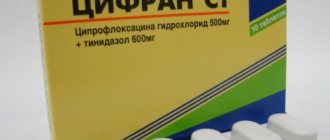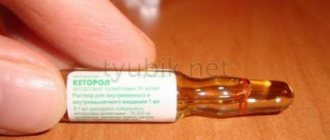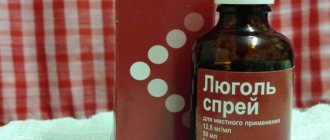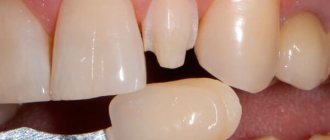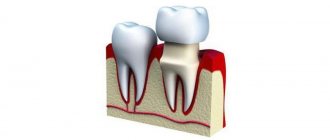Updated: 04/23/2021 15:12:56
Expert: Abramova Tsilya
| Nise | |
| Advantages | Flaws |
| Complex action – reduces temperature, relieves pain, removes inflammation, thins the blood | May be ineffective for severe pain |
| Has many indications for use | |
| Available in several forms | |
| There is a suspension specifically for children | |
| Helps with acute pain syndrome | Tablets should not be used under 12 years of age |
| Ketonal | |
| Advantages | Flaws |
| Stronger analgesic effect, effective for severe pain | More contraindications |
| Many release forms | Cost is higher |
| Injections help quickly relieve acute pain syndrome | Does not apply to children under 14 years of age |
| Starts to act quickly | Higher risk of gastrointestinal adverse reactions |
| The effect lasts for a long time | |
Mechanism of action of NSAIDs
The action of painkillers is based on the suppression of COX.
COX stands for cyclooxygenase . The title is difficult to read, but its meaning is relatively simple. COX is a group of enzymes that are responsible for the formation of inflammatory mediators. If you block this enzyme, the symptoms of inflammation and pain are eliminated.
There are COX-1, COX-2 and COX-3. Type 1 cyclooxygenase is constantly produced in a healthy body, performing protective functions. One of these functions is the production of protective mucus in the stomach. The body produces COX-2 under conditions of illness, for example during inflammatory processes.
If a drug acts selectively on COX-2, the drug is called selective. Drugs that inhibit both COX-1 and COX-2 are considered non-selective.
Non-selective agents cause more side effects and have more contraindications.
"Nise"
The active substance "Nise" is called nimesulide . Nimesulide acts selectively: it suppresses only COX-2. Thanks to its selective action, it has fewer side effects.
3 main effects of “Nise”:
- Anesthetic.
- Anti-inflammatory.
- Pronounced antipyretic.
The action begins after 1.5-2.5 hours. The speed of onset of the effect depends on the characteristics of the body and the severity of pain.
Indications
The active substance penetrates well into the joint fluid and female genital organs. Due to this, nimesulide is prescribed for:
- Gout.
- Diseases of joints, ligaments, muscles.
- Toothaches.
- Osteochondrosis.
- Painful menstruation.
Nimesulide only relieves symptoms and does not change the outcome of the disease.
Contraindications
"Nise" is contraindicated for:
- Allergies to nimesulide, aspirin or other painkillers.
- Bronchial asthma.
- Peptic ulcer of the stomach and duodenum.
- Kidney and liver failure.
- Pregnant and lactating women.
- Bleeding from the gastrointestinal tract.
- Inflammatory bowel diseases during exacerbation.
Release forms
The drug is available in the form of a gel for external use and tablets for oral administration.
- Tablets 100 mg. Suitable for adults and children over 12 years old.
- Soluble tablets 50 mg. Designed for children from 3 years old.
- Gel 1% in tubes of 20 g. and 50 gr.
Mode of application
Gel: apply to the painful area 3-4 times a day .
Tablets 100 mg: adults and children over 12 years old - 1 tablet 2 times a day after meals.
Soluble tablets 50 mg: the dose and regimen are determined by the doctor, based on the weight and condition of the child.
Side effects
The instructions for use describe all possible side effects. Below are just the ones that are most common:
- Dizziness.
- Skin itching, rash.
- Swelling on the face.
- Loose stools.
- Nausea, vomiting.
- Increased liver enzymes.
Description of Ketonal
Analgesic Ketonal is available in the form of tablets, gel, suppositories, capsules, solution, cream. It has an analgesic effect, relieves fever, and has an anti-inflammatory effect. Manufacturer – Lek dd The active ingredient is ketoprofen, one of the most powerful COX inhibitors.
The main properties of ketoprofen are analgesic, decongestant, and anti-inflammatory. Ketonal is used to eliminate symptoms and does not affect the progression of the disease.
Research and effectiveness
Ketonal is widely used for rheumatoid arthritis. It is no different in effectiveness from well-known NSAID drugs such as ibuprofen and diclofenac. Ketonal can be rationally used to relieve pain in diseases of the musculoskeletal system.
When administered intramuscularly, the effectiveness of Ketonal is higher than that of diclofenac and ibuprofen. It is considered one of the most powerful in its analgesic effect. The product is effectively used for muscle pain and post-traumatic inflammation.
For rheumatological pathology, Ketonal better eliminates pain and inflammation. the positive effect occurs faster and lasts longer. For closed injuries, it is effective to use the medicine in the form of a gel. The advantage in this case will be a local effect without maintaining a high concentration of the substance in the plasma.
Source: Chichasova N.V. "Efficacy and safety of Ketoprofen in rheumatoid arthritis." 2001.
Contraindications
Ketonal has the following restrictions on its use:
- hypersensitivity to active substances;
- bronchial asthma, polyposis, intolerance to acetylsalicylic acid;
- photosensitivity;
- skin damage when using the gel;
- pregnancy period;
- up to 14 years old;
- ulcerative and erosive disease of the stomach;
- severe kidney and liver disorders;
- chronic heart failure;
- exacerbation of renal porphyria;
- blood diseases.
In the 1st and 2nd trimesters of pregnancy, the drug is used in case of urgent need only for external application. In the last months of gestation, Ketonal is contraindicated. It is not recommended to use the medicine during lactation; there is no data on its excretion into milk.
Side effects
The drug is well tolerated in low dosages. Allergic reactions are possible. Adverse reactions occur rarely and go away on their own. There is a possibility of dyspeptic symptoms, dizziness, anemia, and asthma.
There is also a risk of liver failure, insomnia, confusion, petechial rash, and erosive damage to the gastric mucosa. If any symptoms occur, symptomatic treatment is indicated. You need to stop taking the medication and consult a doctor.
Dosage
Ketonal tablets are prescribed 1-2 pieces 2-3 times. It is recommended to drink immediately after eating. At the same time, suppositories can be used to enhance the therapeutic effect. Candles are shown 1-2 per day.
Ketonal solution is administered intramuscularly at 10-100 mg up to 3 times. The drug in injections is used only in a hospital under the supervision of a doctor. In case of severe pain, the drug can be prescribed simultaneously with narcotic analgesics.
Who is it suitable for?
The drug is used for symptomatic treatment. It copes with pain and inflammation. The medicine is used for any disease that is accompanied by pain, provided there are no contraindications.
In particular, Ketonal is used for the following indications:
- arthritis;
- periarthritis;
- osteoarthritis;
- spondyloarthritis;
- bursitis;
- neuralgia;
- myalgia;
- radiculopathy;
- tendinitis;
- joint damage due to psoriasis.
"Ketorol"
The active ingredient of Ketorol is ketorolac. The mechanism of action of ketorolac is based on the suppression of COX types 1 and 2. That is, “Ketorol” is a non-selective pain reliever.
Ketorolac has the following effects:
- Anti-inflammatory effect.
- Pronounced pain reliever.
- Moderate antipyretic.
The analgesic effect is comparable to that of morphine. "Ketorol" acts quickly: pain decreases within 10-78 minutes after administration.
Indications
The drug is prescribed to relieve severe pain with:
- Injuries.
- Dental diseases.
- In the postoperative period.
- For pain in the back, joints, muscles.
Contraindications
"Ketorol" has the same contraindications as "Nise". Additionally, due to its non-selective effect on COX, the drug cannot be used for:
- Blood clotting disorders.
- Heart failure.
- In the period after surgery to install a coronary bypass.
- Not used to prepare for anesthesia before surgery due to the increased risk of bleeding.
- Age up to 16 years.
Release forms
"Ketorol" is available in 3 forms:
- Tablets 10 mg for oral administration.
- Gel 2% for external use.
- Solution for injection in ampoules.
Mode of application
Tablets: 1 tablet up to 4 times a day . The duration of treatment is no longer than 5 days.
Gel: apply to areas of maximum pain up to 4 times a day.
Side effects
The most common side effects are:
- Loose stools.
- Stomach pain
- Inflammation of the oral mucosa.
- Swelling of the face, legs, toes
- Vomiting is especially common in elderly people over 65 years of age.
- Headache.
- Dizziness.
- Drowsiness.
The instructions for use also describe other complications that Ketorol can cause. Before taking the drug, you should carefully read the instructions.
Problems of outpatient practice in three dimensions. X Wayne Readings
Among outpatients seeking help from a general practitioner, the majority suffer from chronic pain of varying severity and localization. However, not all therapists promptly determine the presence of pain and can prescribe adequate pain therapy. Issues of the pathogenesis of pain, the relationship between pain syndrome and somatic diseases, as well as the principles of prescribing analgesic drugs were considered within the framework of a specialized symposium by employees of the Department of Therapy, Clinical Pharmacology and Emergency Medical Care of the Moscow State Medical and Dental University. A.I. Evdokimov. Presentations were made by Ph.D. Anna Vladimirovna NOSOVA, Ph.D. Anton Sergeevich SKOTNIKOV and Doctor of Medical Sciences, Professor Arkady Lvovich VERTKIN.
Ph.D. A.V. Nosova
Ph.D. A.S. Skotnikov
Professor A.L. Vertkin
Rice. 1. Adverse effects of pain on the cardiovascular system
Rice. 2. Reduced risk of cardiovascular accidents while taking ketorolac (frequency of myocardial infarction after surgery)
Rice. 3. Safety of amtolmetin guacil compared with other NSAIDs (indomethacin, tolmetin, diclofenac): results of a meta-analysis
Rice. 4. Comparative costs of treatment with Naisylate and traditional NSAIDs
Pain is one of the main reasons for visiting a doctor
How acute is the issue of pain in a therapist’s practice and how often does he encounter such patients? In order to operate with data that is relevant for modern Russia, the speakers conducted outpatient visits with patients for 7 days together with a therapist, after which they analyzed the results. Most often (in 72% of cases), patients over 35 years of age sought help due to the worsening of an existing chronic disease, such as arterial hypertension or diabetes mellitus, while 88% of patients answered in the affirmative when asked whether they suffered from chronic pain. According to the emergency medical care register, chronic pain syndrome in the Russian population usually occurs in people of working age, is characterized by high intensity and often recurs. Pain can have different localizations, but most often the joints and back are sources of discomfort. The most common causes of chronic pain are arthritis (osteoarthritis), herniated discs, and trauma. Chronic pain syndrome is often protracted: 27% of patients suffer from it for 5–10 years, and another 12% for more than 10 years. It is important that during this time the intensity of pain and the duration of attacks only increase, so their relief becomes an increasingly difficult task. As the pain syndrome progresses, it significantly worsens the patient’s quality of life, causing him to feel fear, helplessness and fatigue. Patients often reach a stage of desperation where using, for example, veterinary drugs begins to seem like an acceptable solution. Obtaining adequate prescriptions from the attending physician is complicated by the fact that the pain can be localized both in the spine and in the joints of the limbs, so the patient does not know which specialist to contact.
Primary care doctors, as a rule, rarely ask questions about pain (especially if the disease for which the patient is referred does not involve severe pain), so the huge problem of chronic pain almost completely disappears from the attention of therapists. Only 24% of doctors mention pain in the outpatient chart. Meanwhile, providing all patients suffering from pain in the spine or joints with adequate medical care is the task of primary care doctors. It is necessary to refer patients to a neurologist only when it is really impossible to do without consulting a specialist. If we are talking about a standard case of pain caused by damage to the osteoarticular system, the therapist must select an effective treatment independently.
Pain and somatic diseases
“Degenerative pathology of the osteoarticular system is becoming a serious problem. The rate of increase in morbidity in this area today is even faster than the increase in the incidence of heart and vascular diseases,” noted Professor A.L. Vertkin.
According to A.S. Skotnikova, a paradoxical situation arises in the outpatient healthcare sector. The procedure for providing medical care to the adult population in the “rheumatology” profile is clearly and unambiguously stated in the relevant order of the Russian Ministry of Health. Thus, primary care for rheumatological patients is provided by a therapist, who often does not even ask patients about the duration and severity of pain. Meanwhile, chronic pain syndrome is closely related to comorbidity, which in turn is a purely therapeutic problem that cannot be fundamentally solved by the efforts of specialized specialists. The core of somatic polymorbidity at the nosological level is cardiovascular pathology, and at the level of typical pathological processes - systemic inflammation, accompanied by the release of pro-inflammatory cytokines and destructive mediators. Systemic inflammation plays a key role in the development of comorbidity, whether it manifests itself in the form of cardiovascular disease, chronic obstructive pulmonary disease, or musculoskeletal disease. This means that in the treatment of such patients it is impossible to do without drugs that have an anti-inflammatory effect.
Pain relief becomes a matter of not only the quality of life, but also its duration, since severe pain in itself can have an adverse effect on the cardiovascular system (Fig. 1).
Against the background of pain, the risk of developing a hypertensive crisis, acute coronary syndrome and heart rhythm disturbances increases. Today, it is considered proven that during a hypertensive crisis, a so-called cytokine storm develops - the level of pro-inflammatory interleukins in the blood increases several times. Another typical example of the influence of inflammation on life prognosis is inflammatory processes in an atherosclerotic plaque, ultimately leading to its destabilization, rupture and development of acute coronary syndrome.
“The presence of pain,” emphasized Professor A.L. Vertkin, plays a huge role in the deterioration of the patient’s condition. Due to pain, the patient loses mobility. Immobilization provokes the development of deadly conditions: thrombosis and thromboembolism.” Illustrating his idea, Professor A.L. Vertkin described a clinical case of an 83-year-old patient who died of acute recurrent myocardial infarction, but shortly before death she complained of pain in the joints of the legs, and not of chest pain. An autopsy revealed a lack of cartilage in the knee joints, which apparently led to the development of not only pain, but also multiple hemorrhages, which in turn had a poorly predictable effect on the blood coagulation system as a whole.
The close connection of osteoarthritis with the classical components of multimorbidity is also indicated by the results of a study of the condition of the femoral head ligament in patients who underwent arthroplasty1. The analysis showed that in the ligaments of patients suffering from osteoarthritis, the same changes were present as in the coronary and renal arteries of multimorbid patients, indicating a possible relationship between osteoarthritis and cardiovascular disorders. An association has also been confirmed between the severity of osteoarthritis and the severity of carotid artery stenosis2. Overall, the results of the studies to date suggest that the risk of death in osteoarthritis is closely related to the risk of cardiovascular mortality and all-cause mortality.
Criteria for choosing analgesics
The selection of adequate analgesic therapy in light of the above becomes both an important and quite difficult task, since the lack of pain relief is associated with an increased risk of premature death, and the selection of analgesics is associated with limitations imposed by multimorbidity.
Prescribing certain pain medications to patients with comorbid diseases (for example, Baralgin, produced in India and prohibited for use in this country) can lead to the development of serious adverse reactions, including anaphylactic shock and toxic effects. The most popular drug among patients with pain syndrome is diclofenac, which is deservedly considered the gold standard in the treatment of diseases with inflammatory pathogenesis, but it is not recommended for use in a number of concomitant diseases due to the high risk of gastric bleeding. The situation is complicated by the fact that patients who prefer to choose a drug solely based on its cost purchase low-quality generics of diclofenac, the likelihood of developing adverse reactions when taking them is higher than when taking the original drug.
In principle, the problem of self-medication is extremely acute. Many patients continue to purchase analgesics based on the advice of friends or neighbors rather than on the advice of their physician or for safety reasons. Pain syndrome in patients with a set of comorbid diseases persists for many years, so randomly selected painkillers are also taken by patients for a long time. This leads to the accumulation of undesirable effects and increases the likelihood of developing serious consequences. Even if the patient simultaneously receives antihypertensive or hypoglycemic therapy with drugs that are undesirable to take simultaneously with painkillers, patients, as a rule, cannot refuse analgesics.
Pathogenesis of pain syndrome
Prostaglandins are known to play a key role in the development of pain and inflammatory reactions. However, total inhibition of the synthesis of these substances (more than 30 of them are known today) would lead to the development of severe negative consequences, including disturbances of homeostasis and renal function.
The synthesis of prostaglandins is catalyzed by the enzyme cyclooxygenase (COX), which plays an important role in the development of inflammatory reactions. It is known that COX-1 is involved in the process of platelet activation and aggregation. COX-2 promotes the normal course of reparative processes in tissues. COX-3 is also involved in the synthesis of prostaglandins and plays a role in the development of pain and fever, but unlike isomers 1 and 2, it does not participate in the development of inflammation.
The first line in the treatment of chronic pain is represented by non-steroidal anti-inflammatory drugs (NSAIDs), which block the activity of COX. NSAIDs are characterized by three effects - anti-inflammatory (relevant for the treatment of chronic pain), analgesic (relevant for the treatment of acute pain) and antipyretic (relevant for the treatment of acute inflammation). In this regard, NSAIDs are widely used as a means of symptomatic treatment of neuralgia, toothache, migraines, pain and fever accompanying colds, as well as to relieve the symptoms of dysmenorrhea. In patients with diseases of the musculoskeletal system, NSAIDs can be considered as part of pathogenetic therapy.
When prescribing NSAIDs, it should be remembered that, firstly, the analgesic effect of all NSAIDs manifests itself in doses lower than their anti-inflammatory effect, and secondly, not all effects from the use of drugs in this group are directly related to COX inhibition. There are drugs that can block the production of pro-inflammatory interleukins and suppress the activation of the transcription factor nuclear factor kappa B (NF-kB) in T lymphocytes, which underlies the cascade of inflammatory reactions.
NSAIDs do not affect alteration, which is the first phase of tissue changes in the area of inflammation, however, some drugs, such as indomethacin, affect this phase and can be used, in particular, for gout. Typical NSAIDs provide antiexudative and antiproliferative effects, accelerating healing and preventing the formation of rough scars.
As a rule, patients take NSAIDs as monotherapy, but in approximately 20% of cases it turns out that the patient simultaneously uses two, three or more NSAIDs. It is also common to combine NSAIDs with glucocorticosteroids or anticoagulants. Unfortunately, in some cases, neither doctors nor patients have information about the possible risks of such combination therapy, and 66% of patients remain outside the process of monitoring the side effects of NSAIDs. This problem is relevant and needs additional study.
Ketorol, Nise and Nayzilat - modern means of pain relief
Despite the fact that drugs from the group of non-steroidal NSAIDs differ significantly in safety, as well as some nuances of the mechanism of action, the final choice of drug is significantly influenced by the doctor’s and patient’s opinion about the drug, cost, as well as popularity and brand recognition. In this case, such an important characteristic of an anesthetic drug as the analgesic effect of average doses is often not taken into account. One of the leaders in this indicator is ketorolac (Ketorol) - an intramuscular injection of the drug is equal in strength to taking 12 mg of morphine. Ketorolac is also characterized by an extensive evidence base and a good safety profile, similar to the safety profile of diclofenac.
Ketorolac is an inhibitor of COX-1 and, to a greater extent, COX-2, which plays a key role in the pathogenesis of pain and inflammation. In addition, the drug is characterized by a central analgesic effect. The effect of ketorolac injection develops within 10–15 minutes and lasts for several hours. Ketorolac quickly penetrates the site of inflammation and accumulates there, providing a high concentration and a pronounced analgesic effect.
Ketorolac has relatively low anti-inflammatory activity. But, since the drug is intended for the relief of acute pain, and not for the treatment of chronic inflammation, this property is rather a feature of the drug, and not its disadvantage.
The possibilities of using ketorolac are somewhat limited by the fact that 90% of the active substance is eliminated by the kidneys, which means that elderly people and patients with chronic renal failure need careful titration of the dose, and ketorolac itself must be used strictly according to indications. However, ketorolac is not addictive and combines well with many medications used by comorbid patients.
When prescribing ketorolac, a doctor must take into account that, on the one hand, the drug has antiplatelet activity (this could theoretically lead to an increase in bleeding time). On the other hand, the pharmacokinetics of ketorolac allows its use even in patients at risk of gastropathy. Moreover, there is evidence indicating the cardioprotective properties of the drug (Fig. 2)3.
“Ketorol (ketorolac) today is the gold standard in the relief of intense pain in injuries, metastases, renal colic, in the postoperative period and in many other clinical situations that require fast and reliable pain relief,” concluded A.N. Skotnikov.
If ketorolac is suitable for the treatment of acute pain, then for the relief of chronic pain syndrome it is necessary to choose a drug with proven pronounced anti-inflammatory activity, such as nimesulide (Nise). Nimesulide is characterized by high selectivity for COX-1, a good safety profile and high anti-inflammatory activity when used in low doses. Adverse events from the gastrointestinal tract rarely develop while taking Nise; in addition, the drug stimulates the synthesis of cartilage matrix components and does not have a negative effect on the synthesis of proteoglycans. It is also important that, unlike some other NSAIDs, nimesulide does not affect platelet aggregation and does not increase the risk of thrombosis.
Nise is successfully used to treat chronic pain in the lower back, in the treatment of enthesitis, bursitis and tendinitis. It is also prescribed to patients in the postoperative period and patients suffering from chronic rheumatological diseases, especially osteoarthritis. Nimesulide accumulates in the synovial fluid and provides long-term safe pain relief, simultaneously acting on the central mechanism of pain and inflammation, inhibiting tumor necrosis factor alpha and some cytokines. In addition, nimesulide affects glucocorticoid receptors, but does not have the inherent disadvantages of glucocorticosteroids.
The speakers noted the possibility of sequential administration of Ketorol and Nise. The combination of Ketorol, which has an analgesic effect, and Nise, which has a pronounced anti-inflammatory and anti-edematous effect, is characterized by good tolerability, high efficiency and an affordable price.
However, especially when it comes to elderly comorbid patients, the safety of therapy is given no less attention than its effectiveness. In this regard, a new drug from the NSAID group, amtolmetin guacil (Naisylat), has an undoubted advantage. This is a non-selective COX inhibitor with a fundamentally new mechanism for protecting the gastrointestinal tract. Amtolmetin guacil stimulates capsaicin receptors, which in turn leads to the production of a vasodilating peptide. In addition, amtolmetin guacil affects the metabolism of nitric oxide (NO), and the concentration of NO under the influence of the drug increases exclusively in the stomach, which is a unique feature of the drug that distinguishes it from other COX inhibitors, which are also NO donors.
As a result of taking Naisilate, mucus secretion is stimulated, blood supply to the gastric mucosa is improved, gastric secretion is reduced and the adhesion of leukocytes and neutrophils to the vascular endothelium is reduced. All this together significantly reduces the risk of developing side effects from the gastrointestinal tract while taking Naisilate. To achieve maximum gastroprotective effect, Naysylat should be taken on an empty stomach. The safety of Naisilate and its gastroprotective properties have been demonstrated in randomized clinical trials (Fig. 3)4. Nisylat was found to be comparable to coxibs, which are known to have a low risk of gastrointestinal side effects.
According to A.V. Nosova, the use of Nizilat is not only safe, but also economically beneficial, since when using this drug, patients do not have to spend time and money dealing with unwanted reactions from the gastrointestinal tract (Fig. 4)5. Consequently, the appointment of Naizilat can be considered as an effective, safe and cost-effective solution to the problem of pain of various etiologies.
Conclusion
Thus, chronic pain syndrome is a serious clinical problem due to its high prevalence and variety of forms. Recurrences of pain, its severity and duration seriously reduce the patient’s quality of life, worsening his emotional state. In addition, pain provokes exacerbation of somatic diseases. Effective and safe treatment of pain syndrome is impossible, firstly, without understanding the causes of pain in each specific clinical case, and secondly, without a thorough study of the anti-inflammatory and analgesic effects of various NSAIDs presented on the Russian pharmaceutical market.
When choosing drugs, you should be guided by evidence of the effectiveness and safety of drugs. In this regard, we can highlight Ketorol (ketorolac), which has a significant evidence base. Ketorol is excellent for the treatment of acute pain and has a good safety profile, similar to that of diclofenac. It does not cause addiction and is combined with many medications prescribed to patients with comorbid diseases. For the treatment of chronic pain, it can be recommended to use Nise (nimesulide), which provides long-term safe pain relief while simultaneously influencing the central mechanism of pain and inflammation. When it comes to elderly multimorbid patients, the safety of therapy becomes as important as its effectiveness. From this point of view, the advantages of the modern NSAID Naisilate, which has unique gastroprotective properties and at the same time effectively relieving pain and inflammation, are undeniable.
Differences between "Nise" and "Ketorola"
If you study the instructions for these drugs, it becomes clear that there are differences:
- “Nise” has more pronounced anti-inflammatory and antipyretic effects. Ketorol copes better with pain.
- The effect of Ketorol begins within 10 minutes after administration. The effect of “Nise” will have to wait longer: from 1.5 hours.
- “Nise”, due to its selective action, causes fewer side effects than “Ketorol”.
- "Nise" can be used by children from 3 years of age (in the form of soluble tablets). "Ketorol" has stricter age restrictions - from 16 years.
- "Nise", unlike "Ketorol", does not increase the risk of bleeding. Therefore, it is safer to use in the postoperative period, for example, after tooth extraction.
Comparison of addiction between Nise and Ketonal
Like safety, addiction also involves many factors that must be considered when evaluating a drug.
So, the totality of the values of such parameters as “o syndrome” in Nise is quite similar to the similar values in Ketonal. Withdrawal syndrome is a pathological condition that occurs after the cessation of intake of addictive or dependent substances into the body. And resistance is understood as initial immunity to a drug; in this it differs from addiction, when immunity to a drug develops over a certain period of time. The presence of resistance can only be stated if an attempt has been made to increase the dose of the drug to the maximum possible. At the same time, Nise’s syndrome values are quite small, just like Ketonal’s.
What to choose?
Since both “Nise” and “Ketorol” are prescription drugs, the decision on what to choose is made by the attending physician. The following are just sample recommendations:
- "Ketorol" is better suited for adults, healthy people with severe pain of any origin. Healthy means there should be no diseases of the stomach, intestines, or hematopoietic system.
- "Ketorol" can be used in cases where pain needs to be relieved quickly.
- "Nise" is suitable for older people who have chronic diseases.
- For toothache, the choice of drug depends on the situation. “Nise” is suitable when there is an increased temperature, for example during flux. “Ketorol” will more effectively relieve severe pain due to pulpitis, deep caries, etc.
Medicine and healthComment
